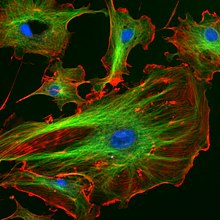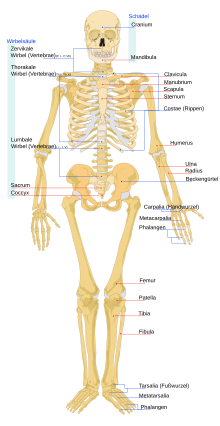skeleton
The skeleton , technically also the skeleton ( gr. Skeletós "dried out body", "mummy"), is in biology or in anatomy the part of the body that forms the supporting structure of a living being . There are two different types of skeleton: the exoskeleton , which forms the stable, outer shell of an organism, and the endoskeleton , which forms the support structure inside the body .
In the figurative sense, a skeleton is also understood in technology to be a supporting structure, for example a building.
Cytoskeleton
The cytoskeleton ( Greek κύτος kýtos , "cell" , actually "vessel, bulge") serves to stabilize and maintain the shape of the cells. Furthermore, cells can use it to move and transport substances inside them. In addition, parts of the cytoskeleton also take on tasks in signal transmission between cells. It consists of thin proteins that the cell can build up and break down again as needed. These are called microfilaments and run like fibers in all directions through the cell. There are three different types of filaments in eukaryotes : actin filaments , microtubules and intermediate filaments . The filaments of the prokaryotes are homologous to those of the eukaryotes, but have a different structure.
Hydroskeleton
The simplest skeletal form, which occurs mainly in various invertebrates known as worms , is the hydroskeleton, in which the outer skin muscle, like a hose, compresses the water inside the body. Since water is hardly compressible (i.e. cannot be compressed), the body appears relatively stable.
Exoskeleton

Other animals, especially the arthropods (gr: arthropoda ), and especially insects , chelicerata and crustaceans have developed exoskeletons. As this grows only limited, refer to the individual development usually molts place where during the growth is stripped outgrown shell.
Exoskeletons can be made of different materials. Examples of this are chitin (in arthropods), calcium compounds (in corals , molluscs and some polystyrene ) or silicate (in diatoms and radiolucent animals ).
The exoskeleton of insects not only serves as protection, but also as a surface for muscle attachment , as waterproof protection against dehydration and as a sensory organ for interaction with their environment. It consists of several layers with four functionally different regions: epicuticle , procuticle , epidermis and basal lamina . While most of the arthropod's exoskeleton is made up of chitin, this is not entirely true.
Endoskeleton
The endoskeleton is when the supporting structure of the animals is located within the body. These structures can be found in chordates , echinoderms and sponges . An endoskeleton gives the body support and stability and enables it to move freely . Real endoskeleton comes from the mesoderm , this type of skeleton is found in the chordates and echinoderms.
Sponges
The skeleton of sponges consists of microscopic calcareous or siliceous spicules, the spicules . Another component of the horned silica sponges (Demospongiae) is spongin . The spicula are formed by scelerocytes , a type of cell in the mesogloea (connective tissue-like middle layer). Depending on whether the spicula are formed from lime or silicon dioxide, one speaks of lime or silica sponges .
Echinoderms
The skeleton of the echinoderms , which includes the starfish , consists of calcite and a small amount of magnesium oxide . It lies below the upper skin (epidermis) in the mesoderm and is formed within cell associations of skeletal cells (sclerocytes). This structure (stereom) formed by the sclerocytes is porous and therefore solid and light at the same time. It grows together to form plates (ossicles) that can grow in all directions and thus replace the loss of a part of the body. Joints that connect individual parts of the skeleton can be moved by the muscles .
Chordates
Birds : 23 Eagle 24 parrot 25 domestic chicken (female) 26 domestic chicken (male) 27 Tukan 28 cassowary 29 Penguin 30 crane 31 Barn Owl
reptiles : 32 Kobra 33 pit viper 34 Abgottschlange 35 crocodile 36 lizard 37 turtle
amphibians : 38 frog 39 salamander
fish : 40 perch 41 sturgeon 42 Drückerfisch 43 Rays 44 Pike
The skeleton of vertebrates and those without skulls consists of solid elements that can be moved against each other via skeletal muscles . In humans, and in most vertebrate groups in general, these elements are called bones. Another important building block of endoskeletons is the cartilage . In mammals they are mainly found in the joint areas . In other animals, such as the cartilaginous fish , to which the sharks belong, the skeleton is made entirely of cartilage.
While bone consists of osteocytes (specific cells of the bone), which build up a matrix of collagen around them in which organic elements such as hydroxyapatite crystals (Ca 5 (PO 4 ) 3 OH) are stored, cartilage consists of chondrocytes (specific cells of the Cartilage), which build up a water-rich matrix of proteoglycan and glycoproteins around them. Based on the intercellular matrix, a distinction is made between hyaline , elastic and fibrous cartilage.
In addition to their supporting function of the body and protective function for the internal organs, bones form the mechanical basis that enables movement. At the cellular level, they also serve as calcium and phosphate stores .
Vertebrates
The skeleton of the vertebrate animals has a lot in common, but it differs considerably depending on the habitat and requirements. Comparative anatomy deals with these similarities and differences .
The skeleton of vertebrates is divided into a cranial part ( cranium ) and a postcranial part ( postcranium ). The cranial part includes only the skull , while the postcranium consists of the rest of the skeleton. The postcranium is divided into the axial and the appendicular skeleton. The axial skeleton (axial skeleton) includes the trunk with the spine , sacrum , ribs and sternum . The limbs, the shoulder girdle and the pelvic girdle are assigned to the appendicular skeleton .
fishes
The skeleton of the fish consists either of cartilage ( cartilage fish ) or of bones ( bony fish ). The main characteristics of the fish, the fins , are reinforced with bony fin rays ( radii ). The fins, with the exception of the caudal fin, have no direct connection with the spine, they are only supported by the muscles attached to the fin supports ( radials ). The ribs attach to the spine and also span the abdomen up to the anus. One sternum is missing. The bones consist of ossified connective tissue in the muscle sheaths of the bony fish.
Birds
In order to keep the weight of the birds as low as possible, some of the bird bones are filled with air ( pneumatization ). Some bones have fused with each other in the course of evolution, so that the bird skeleton consists of fewer bones than that of other vertebrates.
Marine mammals
In order to facilitate or enable a locomotion of marine mammals in the water, the front extremities of them have developed into paddle-like fins. The hind legs were either completely lost, e.g. B. in the whales and manatees or united to a uniform tail fin (as for example in seals ).
People
The human skeleton makes up 12 percent of the total weight, so the bones of a person weighing 75 kilograms only weigh nine kilograms. The skeleton of an adult human is made up of just over 200 bones (exact numbers vary between individuals). The human skeleton takes several years to fully develop. Although the upper arm bone (lat. Humerus ) is already ossified (ossified) in the womb (8th week), the skeleton is not fully developed until around the age of 20.
Fossils
Skeletons and skeletal parts as well as their fossilization are among the most important legacies that have been handed down in fossil form by living beings , often even the only ones, especially when they consist of solid substances ( lime , silicate ). This makes them an important source for studying extinct, but also still living species. Softer skeletal parts (made from cartilage, for example), on the other hand, are often only preserved under favorable conditions. So is z. B. Dunkleosteus has only been handed down in fossil form through his skull and neck armor.
From such fossils z. Extensive conclusions were drawn about anatomy, physiology, way of life (living together, diet, reproduction, etc.), distribution and spread, emergence and extinction or relationship to other species. This can be problematic if no other sources are available. For example, similar features can be based on convergent evolution . In addition, the fossil record is often very sketchy.
Archeozoology
Skeletal finds also play an important role in archeology . The field of archeozoology deals with the animal species identification of skeletal finds from archaeological excavations. For this purpose, data is collected and evaluated under ecological and economic aspects. The results provide knowledge of the hunting habits, domestication processes and economic methods of prehistoric and early historical societies. In addition to the species composition, anthropogenic traces on bones , pathologies and the isotope signatures of the skeletal elements provide further data on climatic conditions , food webs as well as food use and composition.
literature
- Milton Hildebrand / George E. Goslow: Comparative and functional anatomy of the vertebrates , Springer, Berlin 2003, ISBN 3-540-00757-1
swell
- ^ Ulrich Lehmann: Paleontological Dictionary . 4th edition. Ferdinand Enke Verlag, Stuttgart 1996, p. 221 .
- ^ NC State University




